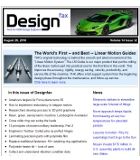 |
| October 22, 2024 | Volume 20 Issue 40 |
Designfax weekly eMagazine
Archives
Partners
Manufacturing Center
Product Spotlight
Modern Applications News
Metalworking Ideas For
Today's Job Shops
Tooling and Production
Strategies for large
metalworking plants
Ferrari F80: New 1,200-hp flagship supercar
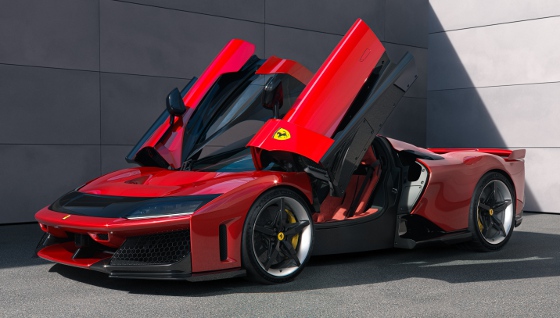
[All images courtesy of Ferrari]
Ferrari's totally new F80 road-legal supercar embodies the ultimate in engineering from the Prancing Horse badge, including top-tier racing design and technology, a mid-mounted turbo V6 internal combustion engine mated with an 800-V hybrid system with three electric motors, tons of aerodynamic features, and a "1+" interior that truly makes the driver central to all the action.
Every aspect of the architecture is conceived to maximize performance, from the carbon-fiber chassis and extreme aerodynamic solutions that are near bonkers for a road-legal car, to the new active suspension optimized to let the driver wring every ounce of performance from the car on the track.
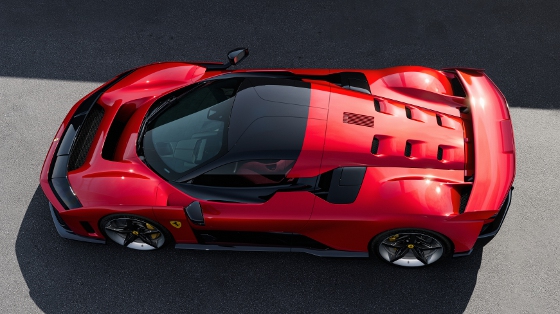
Ferrari says the F80 powertrain is based on the finest expression of technology in motorsport. The GTO and F40 were powered by a turbo V8, because Formula 1 cars used turbocharged engines in the 1980s. Today in both Formula 1 and the World Endurance Championship, powertrains consist of turbo V6 ICE engines mated with an 800-V hybrid system. It was only natural, then, that this architecture -- the same architecture used by the Ferrari 499P, which has taken two consecutive victories at the 24 Hours of Le Mans -- would be transferred into the new F80 supercar.
The F80's 3-L 120-degree V6 F163CF engine produces 900-hp peak power on its own, making it the Ferrari engine with the highest specific power of all time. The two electric front axle (e-4WD) motors and one rear motor (MGU-K) add another 300 hp. Ferrari says the F80 will do 0 to 62 mph in a blistering 2.2 sec. The transmission is an 8-speed dual-clutch F1 DCT.
Two tire choices, with Pilot Sport Cup2 and Pilot Sport Cup2R variants, are both offered in the sizes 285/30 R20 and 345/30 R21 (front/rear). They were co-developed with Michelin for the F80.
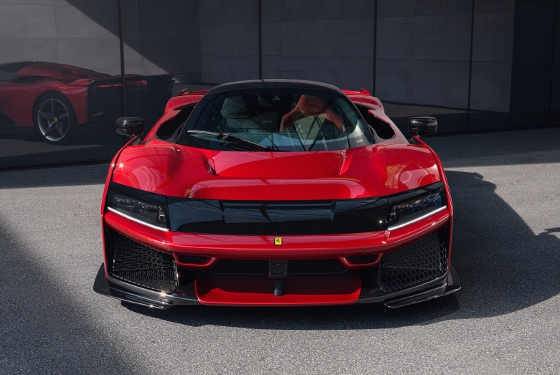
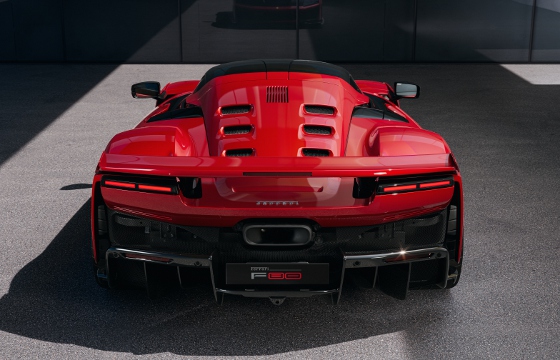
The F80 inherits from Formula 1 both the concept of the MGU-K (with the development of an industrially manufacturable electric motor similar to the unit used in Ferrari F1 cars) and the MGU-Hs (which generate power from the excess kinetic energy from the rotation of the turbines created by the heat energy from the exhaust gases) with a bespoke e-turbo application.
The F80 is also the first Ferrari road car engine to benefit from a new approach for statistical knock control, which lets the engine operate even closer to the knock limit, allowing the use of higher combustion chamber pressures than ever (+20% compared with the 296 GTB) to unleash even more of the engine's potential. Another crucial aspect has been the work dedicated to the dynamic calibration of the torque curve in every gear, an all-time first for a Ferrari road car.
The e-turbos, with an electric motor installed axially between the turbine and the compressor housing, let the engineers optimize the fluid dynamics of the engine for maximum power at mid-to-high engine speeds without the usual compromise in terms of turbo lag at low engine speeds. Ferrari says bringing electric power into the equation makes it possible to define e-turbo management strategies that negate turbo lag and ensure lightning-quick response times.
The electric motors used for the F80 are the first units developed, tested, and manufactured entirely by Ferrari at Maranello, all with the specific goal of maximizing performance and reducing weight. Their design (with two on the front axle and one at the rear of the car) draws directly from Ferrari's experience in racing. The stator and rotor in a Halbach array configuration (which uses a special layout of the magnets to maximize magnetic field strength) and magnet sleeve in carbon fiber are all solutions derived from the design of the MGU-K unit used in Formula 1. The rotor adopts Halbach array technology to maximize magnetic flux density and minimize weight and inertia. The carbon fiber magnet sleeve, on the other hand, has been used to raise maximum motor speed to 30,000 rpm.
A DC/DC converter transforms DC current at one voltage to DC current at a different voltage. This innovative technology makes it possible to use a single component to handle three different voltages simultaneously: 800 V, 48 V, and 12 V.
Using the direct current produced by the high-voltage battery at 800 V, the Ferrari converter generates direct current at 48 V to power the active suspension and e-turbo systems, and 12-V direct current to power the electronic control units and all other electric ancillaries on the vehicle. Innovative resonant technology allows this component to convert current with no latency with a conversion efficiency in excess of 98%, so that it behaves to all intents and purposes as an accumulator.
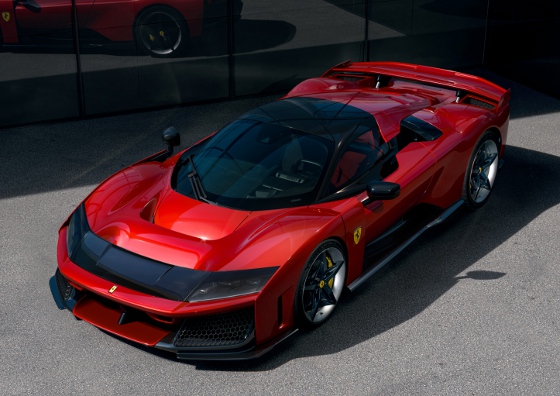
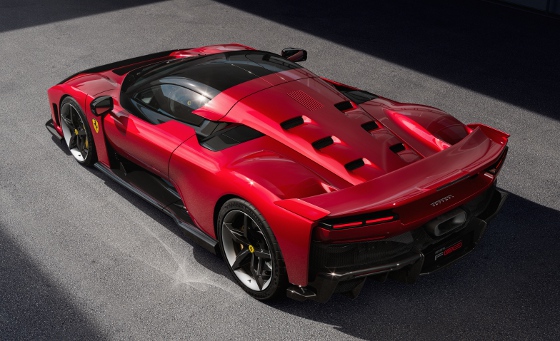
Also developed and manufactured entirely in-house by Ferrari, the front axle includes two electric motors, an inverter, and an integrated cooling system. This component makes it possible to use torque vectoring for the front axle. Another inverter is used for the rear electric motor (MGU-K). This performs three functions: starting the internal combustion engine, recovering energy to recharge the high-voltage battery, and supplementing the torque of the engine in certain dynamic conditions. It can generate up to 70 kW in regeneration mode and assist the internal combustion engine with up to 60 kW of power.
To improve integration between the electric and electronic internal components, Ferrari developed the CSC (Cell Sensing Circuit) wireless sensor suite, which monitors cell voltage with spring contacts and measures cell temperatures with infrared sensors.
The bodyshell of the F80 is completely new and is fabricated from pre-preg carbon fiber and cured in the autoclave using technology derived from Formula 1 and other motorsports. The front hood features an S-Duct consisting of a fixed element connecting the two front wings.
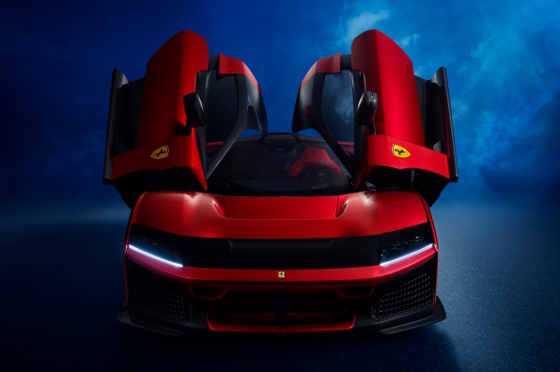
Butterfly doors are used, as on the LaFerrari, with a dual axis-of-rotation hinge mechanism allowing them to open vertically to an angle of almost 90 degrees. The substructure of the doors, a structural element also tasked with absorbing dynamic loads in the event of lateral impact, is constructed from special high-performance carbon fiber.
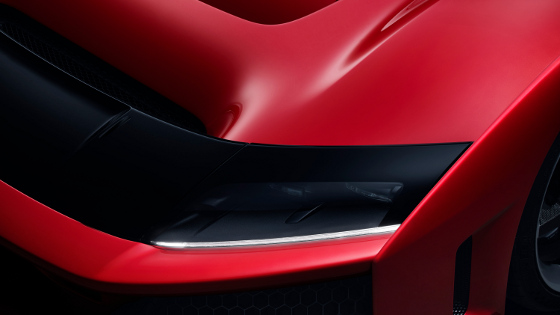
The rear engine cover, which echoes the styling cues of the door from the side view, includes six slots venting hot air from the V6 engine and a grille that also vents air.
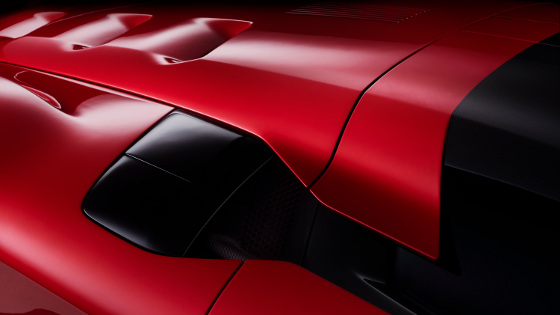
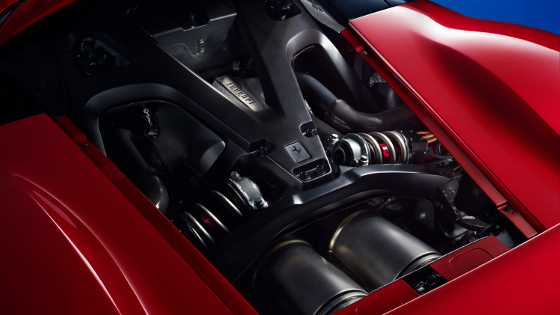
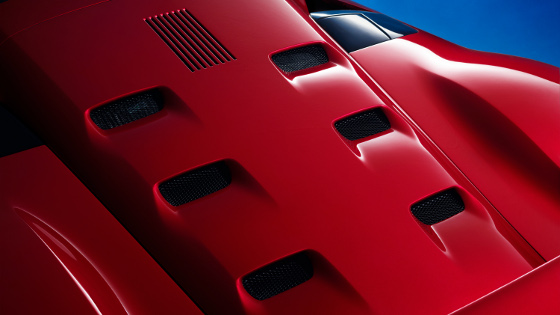
The F80 pushes aerodynamic performance to levels never seen before on a Ferrari road car, as testified by the 1,000 kg of downforce produced at 155 mph (250 km/h). The front end of the F80 alone develops 460 kg of total downforce at that speed.
The body-colored central volume of the nose acts as the generously sized main plane of the front wing. Inside the S-Duct are two flaps following the main profile to complete the triplane wing configuration with curvatures and blower slots clearly inspired by the 499P. Crucial for the aerodynamic efficacy of the front of the vehicle is the way the triplane works in perfect concert with the S-Duct and the high central keel, minimizing blockage of the air flow toward the wing and maximizing performance.
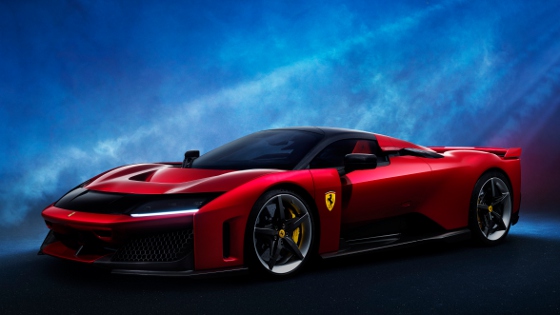
As a result, the air flow from the underbody and bumper undergoes violent vertical expansion and is redirected within the duct toward the front hood, generating a potent upwash that translates into a powerful low-pressure zone under the underbody. This accounts for 150 of the 460 kg of the maximum downforce generated at the front of the car, which is very sensitive to changes in ground clearance. The aerodynamic balance of the car is therefore ensured by the active suspension, which controls the attitude of the vehicle in real time and adjusts the distance between the underbody and the road in response to driving conditions.
The volume freed up under the feet of the driver also made room for three pairs of bargeboards. These devices generate powerful, concentrated vortices that introduce a velocity component to the airflow field in the outwash direction. The bargeboards also help mitigate the detrimental effects of the wake of the front wheel by confining it and keeping it away from the underbody.
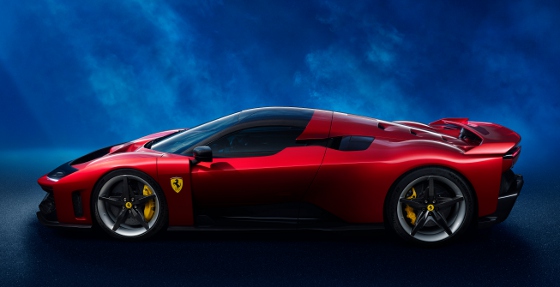
The aerodynamic performance of the rear zone of the car, which generates the remaining 590 kg of downforce at 155 mph, is a result of the combined action of the rear-wing diffuser system. The efficiency of this system is highly dependent on the quantity of downforce produced by the underbody, as this has very little impact on drag.
The active wing is the most visually distinctive aero feature of the F80. The actuator system of the rear wing adjusts not only its height but also controls its angle of attack continuously and dynamically, for precisely dialed-in downforce and drag. In the High Downforce (HD) configuration, which is used during braking, turn-in, and cornering, the wing assumes an angle of 11 degrees relative to the direction of the air flow to generate over 180 kg of downforce at 155 mph.
At the extreme opposite of its range of rotation, the wing is in Low Drag (LD) configuration, with the leading edge pitched upward. Drag is much lower in this configuration, not only because of the reduction in lift, but also due to the tractive effect generated by the residual low-pressure zone impinging on the underside of the wing itself. The new brakes feature motorsports-derived CCM-R Plus (carbon ceramic material) technology.
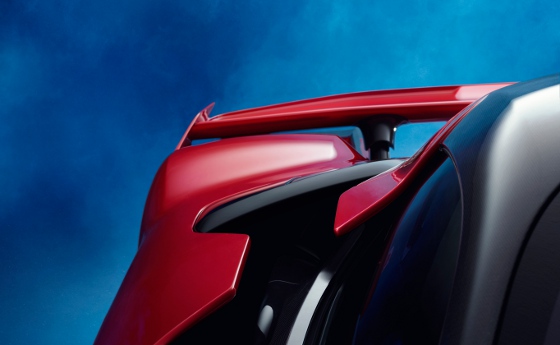
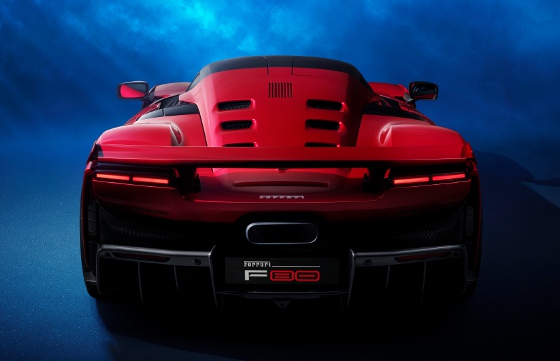
Defining the layout of the cooling system demanded in-depth studies and painstaking development to reconcile the thermal needs of the engine (which has to dissipate over 200 kW of thermal power during performance usage) and the new hybrid system with aerodynamic requisites. The aim was to design a cooling system with the least possible impact on the overall packaging, to attain a functionally and aerodynamically valid configuration that perfectly accommodates both the aerodynamic and thermal demands of the F80.
The compact proportions of the cabin were made possible by opting for a cockpit inspired by a single-seat racer, creating a visual perception akin to an enclosed Formula 1 car. Ferrari calls this layout "1+," because it is all about the driver. If there is a passenger, he or she gets a seat with few creature comforts -- just hold on for the ride.
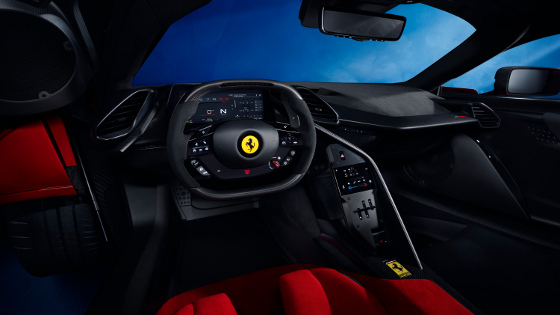
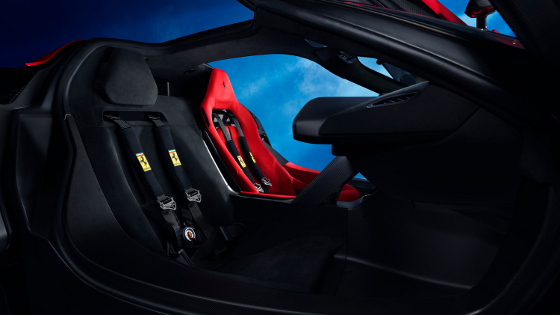
A longitudinal offset in the positions of the seats of the two occupants made it possible to set the passenger seat farther back than the driver seat. This solution let the designers give the car a smaller cabin and reduce the frontal cross-section of the car.
The F80 also boasts a new steering wheel developed specifically for this car. Slightly smaller than its predecessor and with flattened top and bottom rims, the steering wheel also has a smaller boss, improving visibility and accentuating the sense of sportiness when driving. The physical buttons on the right- and left-hand spokes of the steering wheel make a return, replacing the full-digital layout used by Ferrari in recent years with a solution that includes easier-to-use buttons that can be instantly identified by touch.
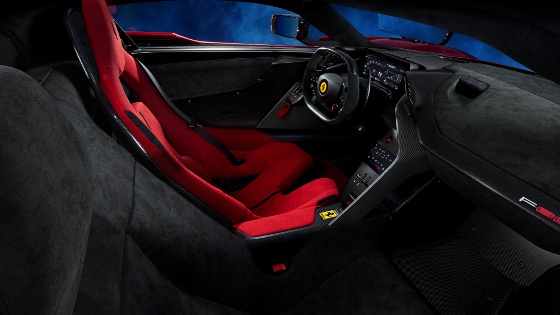
Ferrari has not released pricing yet, but Wired says it is $4 million and the run for now is limited to 799.
Learn more at ferrari.com/en-EN/auto/f80.
Source: Ferrari, Wired (price and number of units only)
Published October 2024
Rate this article
View our terms of use and privacy policy
